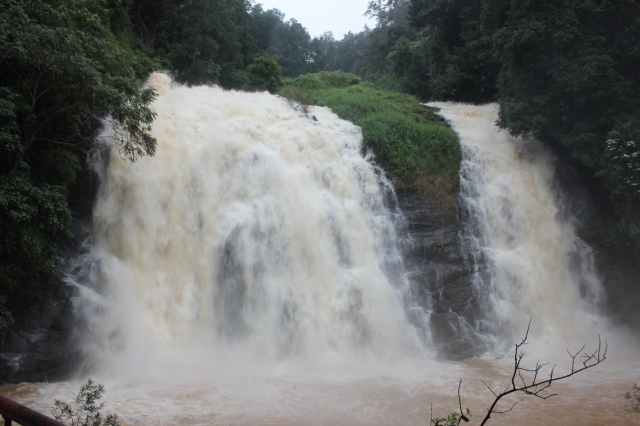KODAGU, also known as COORG, is an administrative district in Karnataka. It occupies an area of 4,102 sq.kms in the Western Ghats of south-western Karnataka. It is the least populous of the 30 districts in Karnataka.
Kodagu is a hilly district, the lowest elevation of which is 3,000 ft. above sea-level. The highest peak, TADIANMOL, rises to 5.740ft, with PUSHPAGIRI, the 2nd highest at 5,627ft. The main river in KODAGU is the KAVERI (Cauvery), which originates at TALAKAVERI located on the eastern side of the Western Ghats, and with its tributaries, drains the greater part of KODAGU.
In July and August, rainfall is intense and there are often showers into November. In jungle tracts, the rainfall reaches 3,000-3,800 millimetres and 1,500-2,500 millimetres in the “bamboo district” to the west. KODAGU has an average temperature of 15 degrees, with the highest temperatures occurring in April and May. The principal town and district capital is MADIKERI or MERCARA.
KODAVU was the native name of KODAGU. The Kodavas were the earliest agriculturists in KODAGU, having lived there for centuries. Being a “warrior community”, as well, they carried arms during times of war and had their own chieftans. The HALERI DYNASTY ruled KODAGU between 1600 and 1834. Later, the British ruled KODAGU from 1834. after the Coorg War, until India’s Independence in 1947. A separate state (called COORG STATE) until then, in 1956 KODAGU was merged with the Mysore State (now Karnataka). The KODAVAS are the dominant community of KODAGU. KODAVA oral traditions are very rich. They revere ancestors, arms and worship a number of deities.
KODAGU is rated as one of the top hill station destinations in India. Some of the most popular tourist attractions in KODAGU include TALAKAVERI. It is the place where the River Kaveri originates. The Temple, on the river banks, is dedicated to Lord Brahma, and is one of only two Temples dedicated to Brahma in India and Southeast Asia..
BHAGAMANDALA is situated at the SANGAM (confluence) of two rivers —- the KAVERI & the KANIKA. A third river, the SUJYOTHI, is said to join from underground, and, hence this spot is called the TRIVENI SANGAM.
IRUPPU FALLS is a sacred Kodagu Hindu spot in the Brahmagiri hill range. The KAKSHMANA TIRTHA river, with the waterfalls, flows nearby and has a Rameshwara Temple on its banks.
OMKARESHWARA TEMPLE is a beautiful Temple built in the Indo-Sarcenic style in KODAGU. A legend is associated with the Temple built by Laingrajendra — 2 in 1820 CE. The King put to death a pious Brahmin who dared to protest against his misdeeds. The spirit of the dead man began to plague the King day and night. On the advice of wise men, the King built this Temple and installed a “Shivlinga” procured from Kashi in North India.
DUBARE is mainly an elephant-capturing and training camp of the Forest Department at the edge of the Dubare Forest, on the bank of the River Kaveri. NAGARHOLE is a national park and wildlife resort. NISARGADHAMA, is a man-made island and picnic spot near Kushalanagar, formed by the River Kaveri.
ABBEY FALLS is a scenic waterfall, 5km from Madikeri. MALLALLI FALLS is 25km from Somwarpet. The TIBETAN BUDDHIST GOLDEN TEMPLE is at Bylakuppe, near Kushalanagar, in the Tibetan Refuge Settlement.
KODAGU is considered rich with wildlife and has 3 Wildlife Sanctuaries —– the BRAHMAGIRI, the TALAKAVERI and the PUSHPAGIRI, and I National Park —— the NAGARHOLE NATIONAL PARK, also known as RAJIV GANDHI NATIONAL PARK.
The flora of the jungle includes ironwood, ebony, Indian mahogany, Poon spar, Black Dammar and rose. In the undergrowth, are found cardamom, areca, plantains, canes and wild black pepper.
In the forest of the less thickly-wooded bamboo country in the west of KODAGU, the most common trees are blackwood, Kino tree, Matthi, Benteak, Dindul and several species of acacia. Teak and sandalwood also grow in the eastern part of the district.
Then here there is the Asian elephant, tiger, leopard, dhole, gaur, boar and several species of deer. KODAGU also has a wide variety of birds, roughly around 300 birds have been sighted and reported over the years.




















